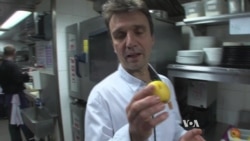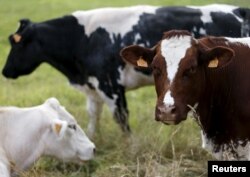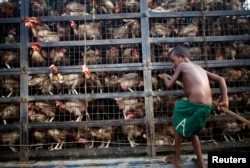Chef Francois Pasteau's culinary philosophy comes served with his golden yellow carrot-ginger soup.
At his restaurant, L'Epi Dupin in central Paris, the carrots come from just outside the city. They're washed, but not peeled. The soup is topped with a spritz of whipped cream, colored light green with pureed carrot tops.
"No waste at all," he said.
The one ingredient he doesn't get locally is fresh ginger, but he can't do without a touch of it. Ginger is key to the flavor.
"You have to be careful to keep the pleasure," he added.
As this gastronomic capital hosts the U.N. climate summit, Pasteau wants to show diners they can eat well and still help the climate.
Leading the way
The food we eat, including the land cleared to produce it, accounts for a fifth or more of all greenhouse gas emissions worldwide, according to the United Nations.
Livestock are responsible for the largest part of agriculture's carbon footprint, and at the same time, people worldwide are adopting more meat-heavy diets like those in the United States and Europe.
It's important to "change the modes of consumption of the countries that are influencing the evolution of the rest of the world," said climate and agriculture expert Alexandre Meybeck with the U.N. Food and Agriculture Organization.
Pasteau wants French cuisine to lead the way.
Ahead of the Paris climate talks, he formed the Good for the Climate Association, signing up 50 restaurants to offer menus featuring local, seasonal vegetables and less meat.
The quality is better and produce has more nutrients when it's local and in season, Pasteau said, and transporting it to market emits fewer greenhouse gases.
Pasteau stresses that it's not about eliminating items from the diet entirely.
"It's not to be punished (for being) good for the climate," he said. "You have pleasure because you have a nice part (of meat), not too much, but a very tasty, very good part."
At a climate conference side event, French Environment Minister Segolene Royal presented Pasteau with an award for his efforts to show that good food also can be good for the climate.
No right way to eat
Meybeck said it's helpful to have chefs take the lead on shifting diets.
"One of the most difficult things to do is to change consumption attitudes," he said. "The worst way to do it, I would say, is to say, ‘You shouldn't do this.' But giving value to other ways of eating is, for me, one of the best ways to do it."
Meybeck cautions there's no right way to eat. It all depends on where you are and where your food comes from. While Westerners tend to eat too much meat, that's not true in much of the developing world, he said.
For example, lack of iron is the world's most common nutritional problem.
"The easiest way to get it is just to eat meat. There's no need to be proscriptive about it," he said.
Chicken has a smaller carbon footprint than beef largely because chickens turn feed into meat more efficiently.
Chicken consumption is rising in the Middle East, Meybeck said, but adds, "The problem with chicken is that they cannot stand heat waves."
As temperatures rise, he said, chickens might require air conditioning. That would blow up their carbon footprint.
As Western diets born of overabundance spread around the world, Meybeck says the point is to recognize the value of what we eat.
"It's really a whole issue of rediscovering the importance that food has," he said. "People who spend 70 percent of their income on food haven't lost this sense. We've lost it here."









